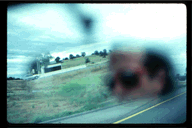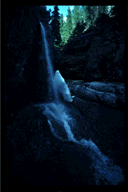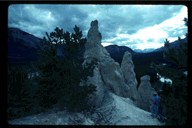
Most computer graphic virtual environments - and video adventure games in particular - that had heretofore fallen in our paths consist of synthetically generated scenery that comes from nowhere on earth. Even the flight simulator examples with airport runways precisely dimensioned and positioned on geographically correct terrain models most starkly reflect the world of cartoons.
One of our objectives with PLACEHOLDER was to experiment with capturing actual places - in the attitude of landscape painting traditions or documentary cinema, for example - using video and audio recorded on location as the raw material for constructing the virtual environment. It must be emphasized that we were not concerned with achieving a high degree of sensory realism - something bristling with polygons and mips that might induce a perfect audiovisual delusion of sticking your head in the "real" waterfall. No, it gets more slippery than that. What we have really set out to capture or reproduce is just the simplest "sense of place."

For one thing, there is the genius loci - a Latin phrase for the "guardian spirit of a place", whose presence accounts for the life of the place and determines its character or essence. Something like this ancient Roman concept is common among indigenous cultures throughout the world. Architectural scholar Christian Norberg-Schulz, who wrote the book entitled Genius Loci, proposes two levels of analysis for articulating the structure of place:



The three locations selected for PLACEHOLDER - cave, waterfall, and river valley - asserted strikingly differentiated characters. By matching capture and representation techniques to the unique qualities of the respective places and by amplifying their contrasts, we hoped to distill distinct environmental caricatures. For example, it was determined that the waterfall model should incorporate motion video to render the dynamic flow of the water. The sense of the cave should be auditory rather than visual - a dimly illuminated quick sketch surrounding a lively array of localized sound sources.
Our predilection for sampling and representing actual places rather than synthesizing environments from scratch was reinforced by the collaboration of Michael Naimark. Techniques for constructing 3D computer models out of camera originated imagery were based on Naimark's previous experiments. One method involved panoramic tiling of multiple video images onto a spherical wireframe.
Another used the video picture as a guide for deforming the surface of the wireframe model to approximate the contours of the original.
Extensive location scouting and a series of preliminary trials reminded us that nature affords few landscapes of sufficiently simple form to reveal themselves to a single point of view. Two questions that abided with us throughout the process deserve further pondering:

Traditions such as Chinese landscape painting, Impressionism and Cubism have experimented with a range of strategies for integrating time and multiple viewpoints into the depiction of places. In the entire history of painting, considering the many achievements that have been made by artists - in the pictorial representation of light and color and texture, for example - it's curious, observed historian Ernst Gombrich, that the development of linear perspective by Brunelleschi and associates is the sole achievement that has been consistently regarded in the category of true scientific invention.

Several years ago Brenda Laurel and I found ourselves along with Michael Naimark working on a video production in Zion National Park. One of the ingredients that Zion offered for our videotaping was Anasazi petroglyphs. We reverently regarded these evocative figures inscribed on the red sandstone faces of Zion as evidence of their creators' profound spiritual connection with the land. Once taping was finished and video gear had been packed to go, that last Sunday morning in Zion we put on hiking boots and made our way to a particularly spectacular trail that climaxed in the Angels Flight, where Brenda claimed to have spotted blue tailed lizards on a previous visit. The steep, tortuous ascent that involved clinging to chains for dear life eventually terminated in a wide ledge that afforded a panoramic view of just about everything. What arrested my attention more than the view was the graffiti. It had spread like virus over every square inch of stone surface that human bodies could reach. All the inscriptions were alphabetical, of course - just the rude monograms that a population of Kilroys leave to mark their excursions far and wide.
The question that occurred to me just then was whether the impulse that motivates people to carve unsightly initials on places might have anything at all in common with the impulse that produced those ancient environmental art works we had been admiring.
Why and how do people mark &/or erase their marks on places? Had we overlooked some innate human proclivity that deserved to be trained and cultivated rather than discouraged? The phenomenon of place marking - a form of behavior that I've studied more carefully since that trip to Zion - yields promising insights about how people might be encouraged to take action in a virtual environment. For PLACEHOLDER, the initial idea was that self-representation of the participants would amount to the marks they leave on things. What would be the virtual equivalent of footprints, graffiti, and shadows, planting flags on the moon or peeing in corners?
Gombrich, E.H. Art and Ilusion: A Study in the Psychology of Pictorial Representation. The A.W. Mellon Lectures in the Fine Arts, National Gallery of Art, 1956. Princeton University Press, Second Edition, 1961.
Norberg-Schulz, Christian. Genius Loci: Towards a Phenomenology of Architecture. New York, Rizzoli, 1980.
Uexküll, Jakob von. "A Stroll Through the World of Animals and Men: A Picture Book of Invisible Worlds," 1934. English translation by Claire Schiller, published in Instinctive Behavior: The Development of a Modern Concept. New York, International Universities Press,
1957.